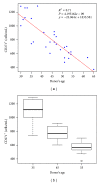Age-related yield of adipose-derived stem cells bearing the low-affinity nerve growth factor receptor
- PMID: 24376462
- PMCID: PMC3859201
- DOI: 10.1155/2013/372164
Age-related yield of adipose-derived stem cells bearing the low-affinity nerve growth factor receptor
Abstract
Adipose-derived stem cells (ADSCs) are a heterogeneous cell population that may be enriched by positive selection with antibodies against the low-affinity nerve growth factor receptor (LNGFR or CD271), yielding a selective cell universe with higher proliferation and differentiation potential. This paper addresses the need for determining the quantity of ADSCs positive for the CD271 receptor and its correlation with donor's age. Mononuclear cells were harvested from the lower backs of 35 female donors and purified using magnetic beads. Multipotency capacity was tested by the expression of stemness genes and through differentiation into preosteoblasts and adipocytes. A significant statistical difference was found in CD271(+) concentrations between defined age intervals. The highest yield was found within women on the 30-40-year-old age range. CD271(+) ADSCs from all age groups showed differentiation capabilities as well as expression of typical multipotent stem cell genes. Our data suggest that the amount of CD271(+) cells correlates inversely with age. However, the ability to obtain these cells was maintained through all age ranges with a yield higher than what has been reported from bone marrow. Our findings propose CD271(+) ADSCs as the primary choice for tissue regeneration and autologous stem cell therapies in older subjects.
Figures




Similar articles
-
Diabetes impairs the angiogenic capacity of human adipose-derived stem cells by reducing the CD271+ subpopulation in adipose tissue.Biochem Biophys Res Commun. 2019 Sep 17;517(2):369-375. doi: 10.1016/j.bbrc.2019.07.081. Epub 2019 Jul 27. Biochem Biophys Res Commun. 2019. PMID: 31362891
-
[Are CD133 and CD271 useful in positive selection to enrich umbilical cord blood mesenchymal stem cells?].Zhongguo Shi Yan Xue Ye Xue Za Zhi. 2010 Oct;18(5):1286-91. Zhongguo Shi Yan Xue Ye Xue Za Zhi. 2010. PMID: 21129278 Chinese.
-
Multipotency and cardiomyogenic potential of human adipose-derived stem cells from epicardium, pericardium, and omentum.Stem Cell Res Ther. 2016 Jun 13;7(1):84. doi: 10.1186/s13287-016-0343-y. Stem Cell Res Ther. 2016. PMID: 27296220 Free PMC article.
-
CD271 as a marker to identify mesenchymal stem cells from diverse sources before culture.World J Stem Cells. 2015 Mar 26;7(2):470-6. doi: 10.4252/wjsc.v7.i2.470. World J Stem Cells. 2015. PMID: 25815130 Free PMC article. Review.
-
Impact of Age on Human Adipose Stem Cells for Bone Tissue Engineering.Cell Transplant. 2017 Sep;26(9):1496-1504. doi: 10.1177/0963689717721203. Cell Transplant. 2017. PMID: 29113460 Free PMC article. Review.
Cited by
-
Adipose Tissue-Derived Stem Cell Yield Depends on Isolation Protocol and Cell Counting Method.Cells. 2021 May 5;10(5):1113. doi: 10.3390/cells10051113. Cells. 2021. PMID: 34063138 Free PMC article.
-
Adipose Derived-Mesenchymal Stem Cells Viability and Differentiating Features for Orthopaedic Reparative Applications: Banking of Adipose Tissue.Stem Cells Int. 2016;2016:4968724. doi: 10.1155/2016/4968724. Epub 2016 Nov 29. Stem Cells Int. 2016. PMID: 28018432 Free PMC article.
-
Current Strategies to Enhance Adipose Stem Cell Function: An Update.Int J Mol Sci. 2019 Aug 5;20(15):3827. doi: 10.3390/ijms20153827. Int J Mol Sci. 2019. PMID: 31387282 Free PMC article. Review.
-
CD271-selected mesenchymal stem cells from adipose tissue enhance cartilage repair and are less angiogenic than plastic adherent mesenchymal stem cells.Sci Rep. 2019 Feb 28;9(1):3194. doi: 10.1038/s41598-019-39715-z. Sci Rep. 2019. PMID: 30816233 Free PMC article.
-
Comparative Analysis of Media and Supplements on Initiation and Expansion of Adipose-Derived Stem Cells.Stem Cells Transl Med. 2016 Mar;5(3):314-24. doi: 10.5966/sctm.2015-0148. Epub 2016 Feb 2. Stem Cells Transl Med. 2016. PMID: 26838270 Free PMC article.
References
-
- De Ugarte DA, Morizono K, Elbarbary A, et al. Comparison of multi-lineage cells from human adipose tissue and bone marrow. Cells Tissues Organs. 2003;174(3):101–109. - PubMed
-
- Kern S, Eichler H, Stoeve J, Klüter H, Bieback K. Comparative analysis of mesenchymal stem cells from bone marrow, umbilical cord blood, or adipose tissue. Stem Cells. 2006;24(5):1294–1301. - PubMed
-
- Puissant B, Barreau C, Bourin P, et al. Immunomodulatory effect of human adipose tissue-derived adult stem cells: comparison with bone marrow mesenchymal stem cells. British Journal of Haematology. 2005;129(1):118–129. - PubMed
-
- Zhu Y, Liu T, Song K, Fan X, Ma X, Cui Z. Adipose-derived stem cell: a better stem cell than BMSC. Cell Biochemistry and Function. 2008;26(6):664–675. - PubMed
LinkOut - more resources
Full Text Sources
Other Literature Sources

